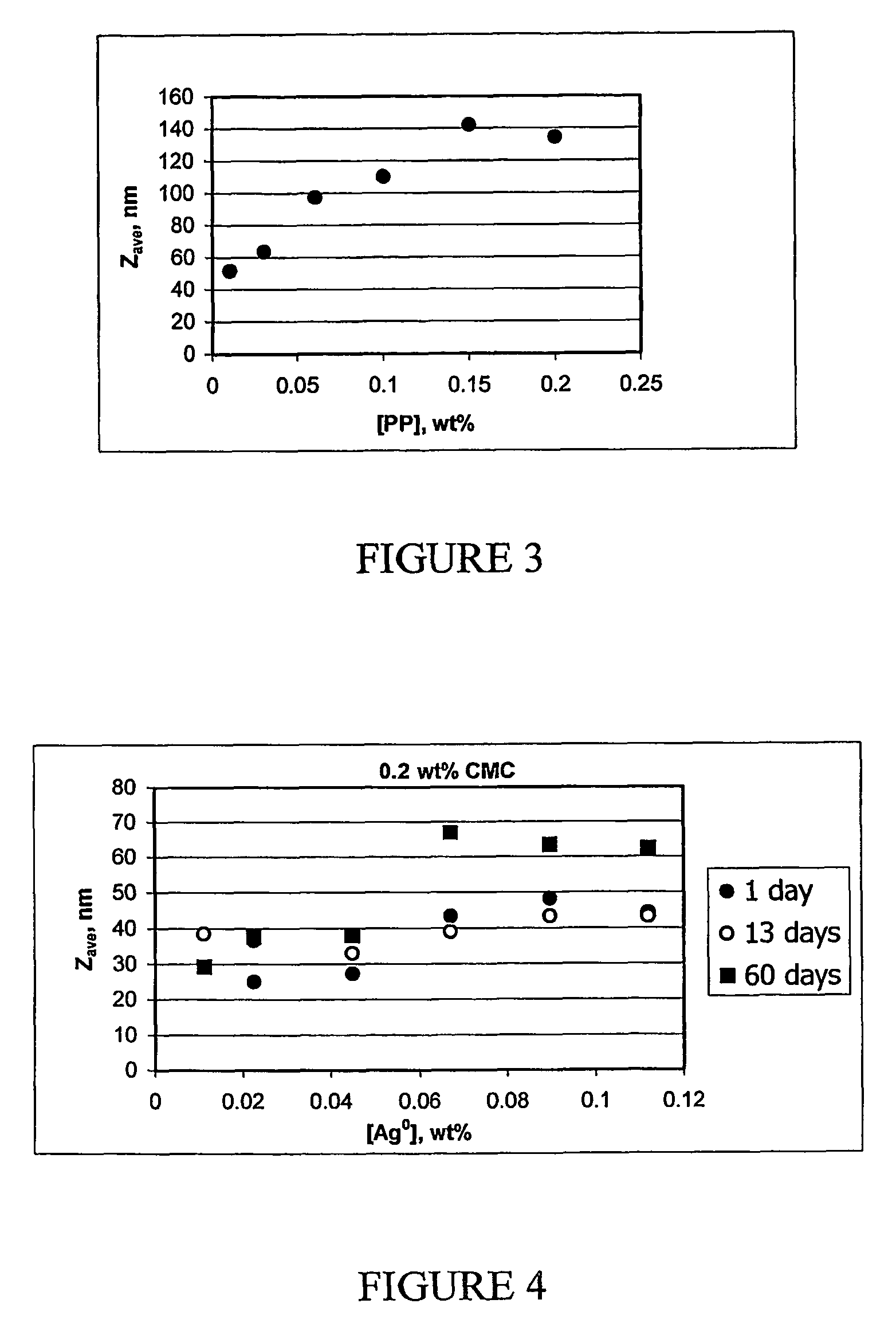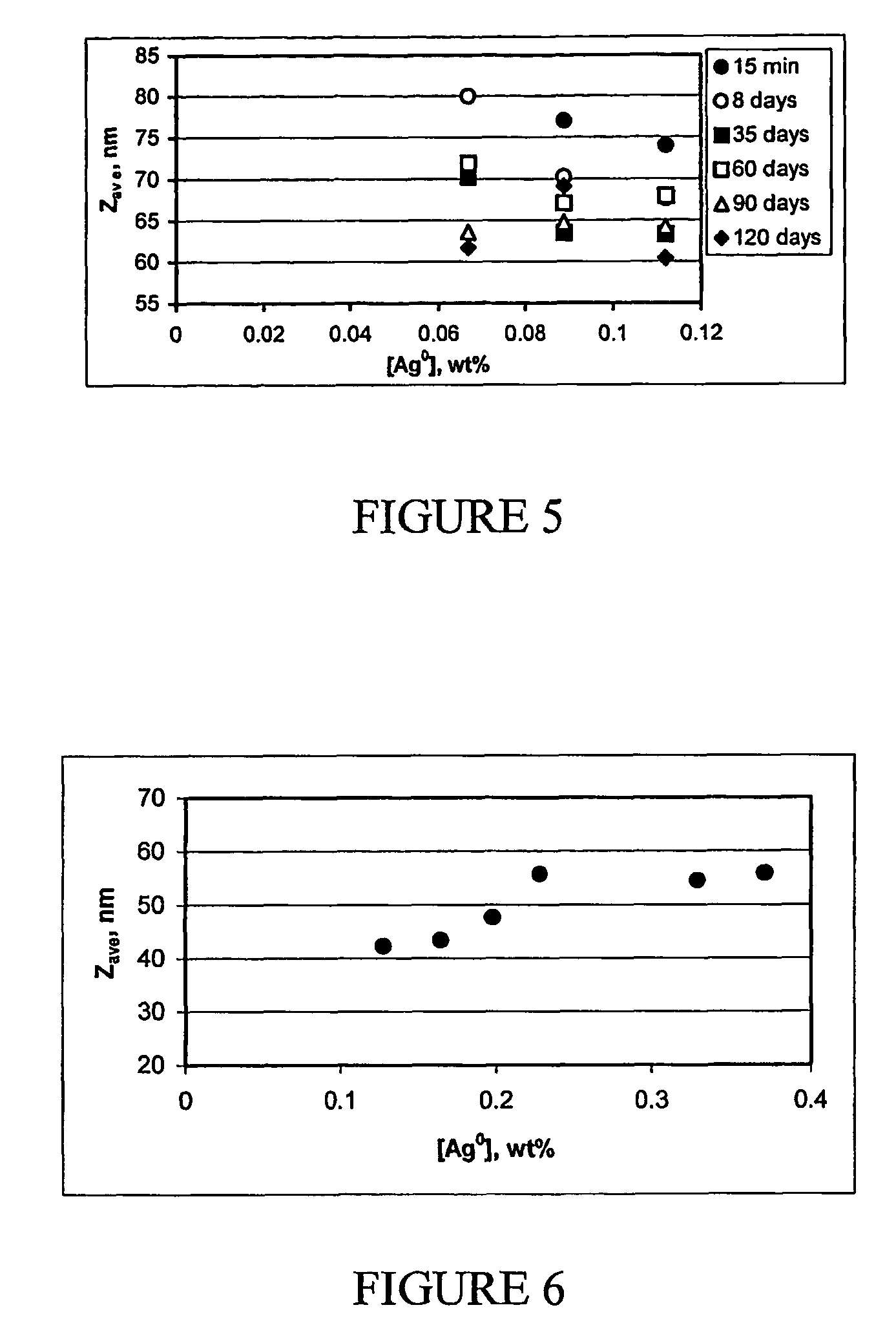Ink-jet inks containing metal nanoparticles
a technology of metal nanoparticles and inkjet printing, which is applied in the direction of printing, non-conductive materials with dispersed conductive materials, and inks. it can solve the problems of difficult adhesion of droplets onto substrates, time-consuming and expensive techniques based on molten metal expelling, and inability to obtain electrical conductivity, so as to improve the possibility of obtaining electrical conductivity, increase the conductivity of printed circuits, and improve the effect of valency ions
Active Publication Date: 2011-06-21
YISSUM RES DEV CO OF THE HEBREWUNIVERSITY OF JERUSALEM LTD
View PDF26 Cites 21 Cited by
- Summary
- Abstract
- Description
- Claims
- Application Information
AI Technical Summary
Benefits of technology
The present invention provides a new method for preparing stable, concentrated metallic nanoparticle dispersions in water-based ink-jet inks. These nanoparticles have very small sizes, which slows down sedimentation and prevents clogging of the ink. The invention also includes the use of polymeric stabilizers to prevent the particles from growing during printing. The invention also describes a new approach for improving the conductivity of printed circuits without sintering at elevated temperatures. The invention also focuses on the use of silver nanoparticles, which have antimicrobial properties and can be used without the need for additional antimicrobial agents. The invention solves the problem of sedimentation in pigmented ink-jet inks and provides a better solution for creating stable, concentrated metallic nanoparticle dispersions.
Problems solved by technology
Microfabrication of such structures by lithographic technique is a time-consuming and expensive process.
Techniques based on expelling small droplets of molten metals onto substrate have met several problems, such as difficulty of adhering droplets onto a substrate, oxidation of the liquid metal, and the difficulty of fabrication a droplet-expulsion mechanism compatible with high temperatures.
Each system has drawbacks: pigments tend to aggregate, and therefore clog the nozzles in the orifice plate, or the narrow tubings in the printhead, thus preventing the jetting of the ink while printing.
Dyes tend to dry, and form a crust on the orifice plate, thus causing failure in jetting and misdirection of jets.
The synthesis of stable colloidal systems with high metal concentration is a serious problem.
However, the preparations of stable silver colloids, described up to now in the literature, in procedures based on reduction of metal from solution, have low metal concentrations, which amount only to 10−5-10−2 M (about 0.0005-0.1%) even in the presence of stabilizers (it is almost impossible to obtain a stable aqueous silver colloid with the metal concentrations higher then 10−3 M without an additional stabilizer, due to immediate particle aggregation).
Method used
the structure of the environmentally friendly knitted fabric provided by the present invention; figure 2 Flow chart of the yarn wrapping machine for environmentally friendly knitted fabrics and storage devices; image 3 Is the parameter map of the yarn covering machine
View moreImage
Smart Image Click on the blue labels to locate them in the text.
Smart ImageViewing Examples
Examples
Experimental program
Comparison scheme
Effect test
example 1
[0083]
Silver nanoparticles (0.18%) in 0.2% CMC solution99.75%, w / wBYK-154 0.25%, w / w
example 2
[0084]
Silver nanoparticles (0.18%) in 0.2% CMC solution94.95%, w / wBYK-348 0.1%, w / wDPnB (dipropyleneglycol butyl ether) 5%, w / w
example 3
[0085]
Silver nanoparticles (1.44%) in 0.1% CMC of solution98.9%, w / wDisperbyk-181 0.1%, w / wDisperbyk-1841.00%, w / w
the structure of the environmentally friendly knitted fabric provided by the present invention; figure 2 Flow chart of the yarn wrapping machine for environmentally friendly knitted fabrics and storage devices; image 3 Is the parameter map of the yarn covering machine
Login to View More PUM
| Property | Measurement | Unit |
|---|---|---|
| size | aaaaa | aaaaa |
| particle size | aaaaa | aaaaa |
| temperatures | aaaaa | aaaaa |
Login to View More
Abstract
Compositions for use in ink jet printing onto a substrate comprising a water based dispersion including metallic nanoparticles and appropriate stabilizers. Also disclosed are methods for the production of said compositions and methods for their use in ink jet printing onto suitable substrates.
Description
FIELD OF THE INVENTION[0001]The present invention relates to the field of ink jet inks and ink-jet printing. More specifically, the present invention describes water based ink-jet inks compositions, which contain metal nanoparticles and polymeric additives dispersed within the liquid vehicle comprising mainly water, and methods for the formation of stable, concentrated dispersions of metallic nanoparticles, and inks containing such dispersions. After printing a pattern on a substrate with the use of ink-jet printer, which is either DOD (drop on demand piezo or bubble), or continuous, a layer of the metal nanoparticles is formed. The thickness of the layer can be increased by printing the specific pattern several times, while drying the ink by means such as hot air, in between printing cycles. After the pattern is printed, the substrate with the printed pattern can be transferred into an oven, in which the nanoparticles can be sintered, thus forming a continuous metal pattern, namely...
Claims
the structure of the environmentally friendly knitted fabric provided by the present invention; figure 2 Flow chart of the yarn wrapping machine for environmentally friendly knitted fabrics and storage devices; image 3 Is the parameter map of the yarn covering machine
Login to View More Application Information
Patent Timeline
 Login to View More
Login to View More Patent Type & Authority Patents(United States)
IPC IPC(8): B05D1/32B05D1/38B05D1/36G01D11/00B41J2/17B41J2/01B05D3/02B41M5/00C09D5/32C09D11/00C09D17/00H01B1/22H01B1/24H05K1/09H05K3/12
CPCC09D5/32C09D11/30C09D11/322C09D17/006H01B1/24H05K1/097H01B1/22Y10T428/31678H05K3/125
Inventor MAGDASSI, SHIOMOKAMYSHNY, ALEXANDERVINETSKY, YELENABASSA, AMALMOKH ABO, RAIM
Owner YISSUM RES DEV CO OF THE HEBREWUNIVERSITY OF JERUSALEM LTD
Features
- R&D
- Intellectual Property
- Life Sciences
- Materials
- Tech Scout
Why Patsnap Eureka
- Unparalleled Data Quality
- Higher Quality Content
- 60% Fewer Hallucinations
Social media
Patsnap Eureka Blog
Learn More Browse by: Latest US Patents, China's latest patents, Technical Efficacy Thesaurus, Application Domain, Technology Topic, Popular Technical Reports.
© 2025 PatSnap. All rights reserved.Legal|Privacy policy|Modern Slavery Act Transparency Statement|Sitemap|About US| Contact US: help@patsnap.com



